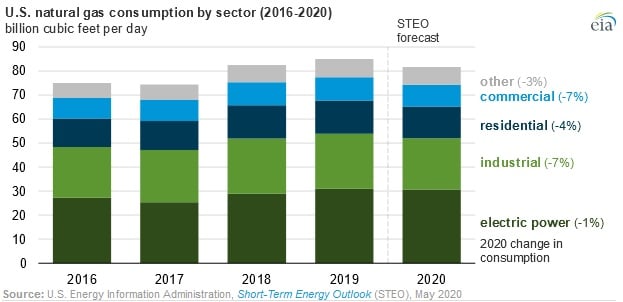U.S. Natural Gas Consumption Projected to Drop in 2020 Driven by Reduced Economic Activity From COVID 19: EIA

U.S. natural gas consumption is expected to fall by 3.4 billion cubic feet per day led by a decline in industrial consumption, according to a May 26 report from the U.S. Energy Information Administration. The agency attributed the decrease to the economic slowdown caused by the COVID-19 pandemic and to milder temperatures in the first quarter of 2020 which reduced the demand for space heating in buildings.
The electric power sector experienced an increase in the first half of 2020, but the agency estimates a decline in consumption in the second half of the year.
Natural gas consumption in the residential and commercial sectors is expected to fall by 3.7 percent and 6.9 percent, respectively. Residential and commercial demand together declined by 5.6 billion cubic feet per day in the first quarter of 2020 compared to the same period last year. The warmer weather felt during that quarter was the main contributor to the decline, with the fifth warmest January on record and 15.7 percent fewer heating degree days than the 10-year average. Outside of winter months, when the demand spikes, these sectors account for a small fraction of natural gas consumption in the country, although the agency estimates a continuous drop due to fragile economic conditions.
Weaker economic conditions will also influence the drop in natural gas demand from the industrial sector, which the agency estimates to be, in average, from 21.4 billion cubic feet per day in 2019 to 19.9 billion cubic feet per day in 2020, marking the first time that demand fell under 20 billion cubic feet per day since the summer of 2016. The natural gas-weighted production index, which estimates manufacturing activity based on industry subsectors and their relative importance to total natural gas consumption, is expected to dip 15.3 percent between January and October of 2020, reaching the lowest level since 2009.
Power sector natural gas consumption is projected to rise by 1.6 billion cubic feet per day in the first half of 2020, compared with the same period from 2019, due to lower prices and lower-than-expected capacity addition. However, the agency estimates a drop of 2.2 billion cubic feet per day in the second half of the year, compared with the respective time frame from 2019, as a result of an increase in natural gas prices
The EIA forecasts an upturn in natural gas prices from $1.88 million British thermal units, in May, to $2.94 million British thermal units, in December, on the Henry Hub spot price, which will lead to coal-fired energy generation units becoming more economically viable than gas-fired units. The agency also expects a decline of 6 percent in total electric power demand in the second half of 2020, compared with the same period in 2019, mainly due to weaker economic conditions.
EnerKnol Pulses like this one are powered by the EnerKnol Platform—the first comprehensive database for real-time energy policy tracking. Sign up for a free trial below for access to key regulatory data and deep industry insights across the energy spectrum.
ACCESS FREE TRIAL